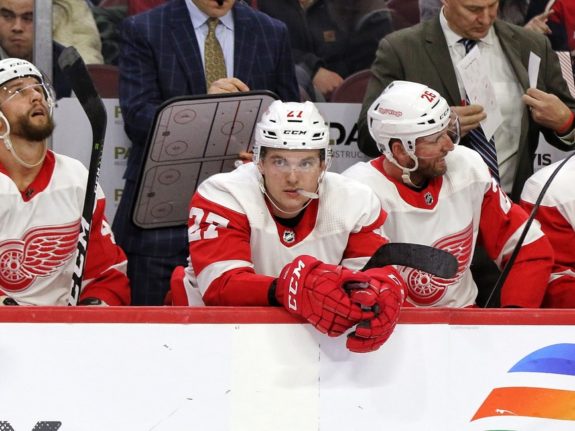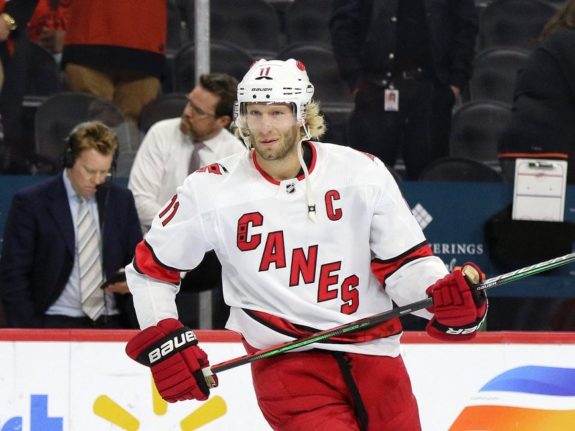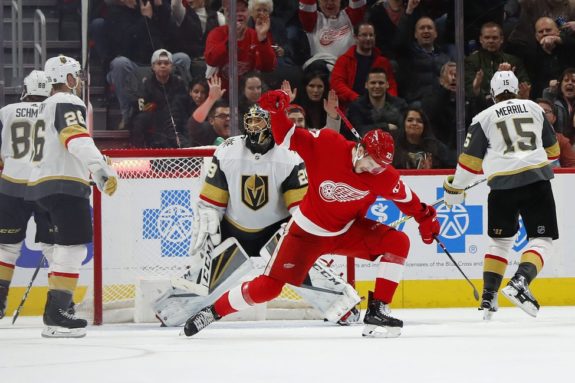“Michael Rasmussen, for me, is the most improved player from a year ago,” Detroit Red Wings head coach Jeff Blashill said at the tail end of the 2020-21 season. ““He’s clearly a better skater, clearly playing with more confidence, a better defensive player. From a year ago to today he’s probably come the furthest in terms of development.”
Heading into this past season, the objective for Rasmussen was quite simple: become an everyday NHL player. While he looked promising in the first month of the NHL season, he was sent down to the Grand Rapids Griffins of the American Hockey League (AHL) right before the beginning of their season. The 6-foot-6 forward spent just seven games down in the minors (where he collected six points along the way) before he was called back up to the NHL and the Red Wings. From there, he never looked back.
Now make no mistake, Rasmussen did not set the world on fire last season. Through 40 games in the NHL, he managed to record just three goals and 12 points while playing up and down Detroit’s lineup. Through 102 total games of NHL experience, the Red Wings’ top pick in the 2017 draft has 11 goals and 30 points. Those are not exactly the totals that you envision when you hear a player’s name called at the ninth selection of a given draft.
And yet despite his lack of offensive output, there are a lot of reasons to get excited about this player. Now that Rasmussen has crossed the threshold of becoming a bona fide NHL forward, the 22-year-old has the opportunity to carve out a role for himself that will place him firmly in the Red Wings’ plans in the present and the future.
Michael Rasmussen: Shutdown Center?
Drafted as a center back in 2017, Rasmussen’s ultimate upside remains down the middle. While a common thought out there is that the Red Wings could slide him over to the wing to give an opportunity to another young center like Joe Veleno to make the team, such a move would take away from what makes Rasmussen’s toolkit so unique. He is easily Detroit’s tallest/largest forward, and that should translate to multiple opportunities in the 2021-22 season, especially after he received similar opportunities last season.

“I think he’s a guy that’s shown that he was ready for the opportunity,” Blashill said. “He’s been out there five-on-six. He’s been out there six-on-five. Power play, penalty kill…You hope that expediates his development.”
All of that in-game experience will help Rasmussen more than anything else. Playing in those big-game moments helps boost confidence, and with that comes added playing time and responsibility (he averaged 14:48 in ice time this past season.) That he seems to have gained the head coach’s trust is a very positive sign for a player that was on the verge of being forgotten as “sexier” names like Filip Zadina and Lucas Raymond joined the Red Wings’ prospect pool.
Watching him on the power play, it’s easy to see what the coaches and the organization envision him as in his prime. Like Tomas Holmstrom before him, Rasmussen often parks himself in front of the opposing goaltender, setting up a screen and making himself available to tip the puck or bang it home on a rebound. He is not a facilitator nor is he the person that is going to transport the puck, but if the Red Wings manage to score on the power play, they’re hoping that No. 27 prevents the goalie from ever getting a good look at it.
His goal and point totals will tell you that his power play and overall offensive abilities have not fully blossomed yet. Where his game is maturing in a noticeable way is in his compete level and in the defensive side of his game. During one of the Red Wings’ practices, Rasmussen was caught practicing face-offs with now-former Red Wing Luke Glendening.
Rasmussen won just 44.4 percent of his 302 faceoffs in 2020-21; Glendening won 60.9 percent of his 859 draws. Giving a boost to Rasmussen’s faceoff percentage is in Detroit’s best interest, especially considering their hope for him is that he will develop into a top-tier shutdown center in the NHL.
“We feel like if he can become a center that can play the other team’s best and can shut the other team’s better players down,” Blashill said back in February. “Similar to what (Carolina Hurricanes center) Jordan Staal does, who is a heck of a player in the league and that’s a mouthful to ask, but if he can become that kind of model, that’s a huge asset.”
Staal, who was drafted second overall by the Pittsburgh Penguins back in 2006, is widely known as one of the best two-way centers in the league, though his defensive upside is higher than his offensive upside. To that point, through 1,014 regular season games in the NHL, his points per-game rate is .57, with the highest rate, .81, coming in the 2011-12 campaign, his final season with the Penguins. He can score, especially when he’s playing in the middle six, but it’s not exactly what he’s known for.

It’s easy to see why the Red Wings would target Staal as the type of player they would like Rasmussen to model himself after. Like the Hurricanes’ captain, “Ras” is in a position where he’ll never be a team’s top center, but he can provide quality depth as a match-up center that takes on the opposing team’s top players. While Staal has enough skill that he can average just over half a point a game, Rasmussen doesn’t seem to have that same offensive skill – though 102 games is not nearly enough to say the jury is out on the issue. His ability to play that match-up role is what will keep in the league; how much offense he is able to produce will determine how high up in the lineup he’ll play.
Fit on the 2021-22 Red Wings
You could make a solid argument for Rasmussen to play down the middle on any of Detroit’s lines outside of the top line. As it stands right now, Dylan Larkin will likely play on the top line, and Robby Fabbri or Pius Suter will jockey for the second line role. That leaves the third and fourth line up for grabs, with Rasmussen having the inside track on claiming the third line center role.
A third line role should be perfect for Rasmussen, especially considering the type of player the Red Wings hope that he will become. The third line of any team is often characterized by being the team’s best defensive line while also having the ability to provide energy and depth scoring to the team. Depending on his linemates, the Vancouver native has the ability to take on some of the defensive responsibility vacated by Glendening, and he can chip in on offense here and there. Of course, he should also continue to see time on both the power play and penalty kill.
Resetting Expectations of Rasmussen
Now that Rasmussen has announced himself as an NHL regular, the hope now is that fans and pundits have sort of reset their expectations of the former ninth overall pick. Chances are slim that his offense will ever live up to that draft slot – other players selected ninth overall include Dougie Hamilton (2011), Nikolaj Ehlers (2014) and Mikhail Sergachev (2016). While he may never become a top line player, there’s still all the opportunity in the world for him to become a quality bottom six player that takes on the tough assignments so that the team’s top players can feast on lesser competition. It’s not a super flashy role, but it is an incredibly important one – especially when your team doesn’t have a player capable of filling that role.

If Rasmussen can come anywhere close to the kind of success/career that Staal has had, that will be huge for the Red Wings as they continue to work towards building a contender. Even if he can’t reach those heights, he can still hold down a job in the NHL as a defensive center whose physical tools are undeniable. With a newly-signed three-year deal in-hand, his 2020-21 season seems to have won over both Blashill and general manager Steve Yzerman, at least in the short term.
Rasmussen took some big steps this past season. If he is going to become a part of the Red Wings’ long term plans, however, he’ll need to continue to take steps. If he can score 10 to 15 goals and record 30 to 35 points while becoming one of, if not THE best defensive forward on Detroit’s roster, that’ll be another positive development for a player who absolutely must keep moving things in the right direction. That’s what it takes to go from the “most improved” player to a player that is most important.
